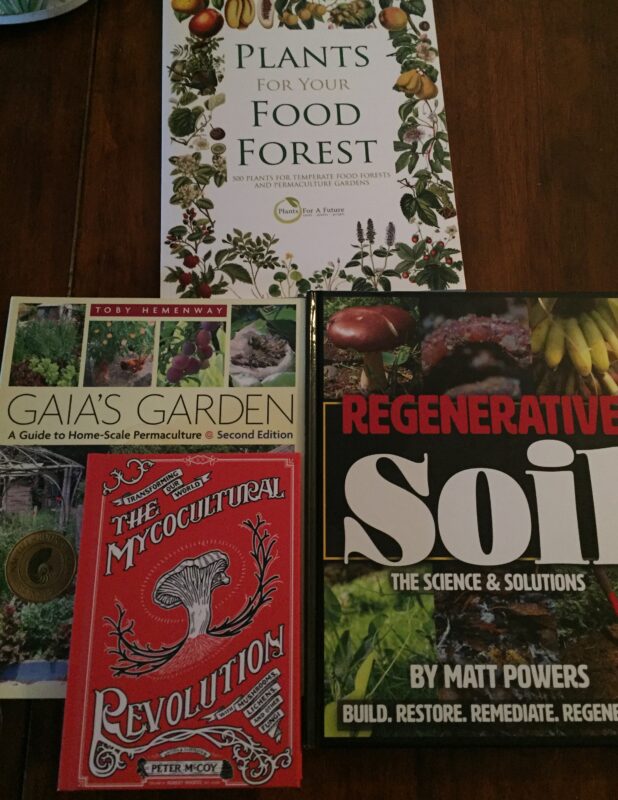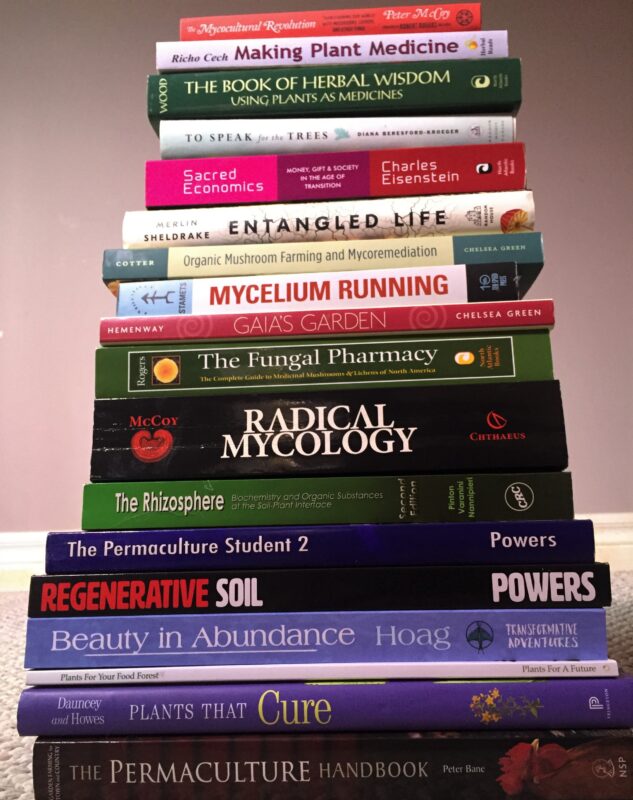Uncategorized
Book Recommendations and info on Food Forests


Additional book suggestions and a links to some good video presentations at the bottom:
– The Holistic Orchard by Michael Phillips
– Trees for Gardens, Orchards, and Permaculture by Michael Crawford
– Farming the Woods by Ken Mudge and Steve Gabriel
– Integrated Forest Gardening by Daniel Halsey, Wayne Weiseman, and Phil Ruddock
– The Forest Garden Greenhouse by Jerome Ostentowski
– Perennial Vegetables by Eric Toensmeier
– Paradise Lot by Eric Toensmeier
– Around the World in 80 Plants by Stephen Barstow
– The Reference Manual of Woody Plant Propagation by Michael A. Dirr and Charles W. Heuser, Jr.
– The Resilient Gardener by Carol Deppe
– The Market Gardener by Jean-Martin Fortier
– The Urban Farmer by Curtis Stone
– The Lean Farm by Ben Hartman
– The Horse-Powered Farm by Stephen Leslie
– Breeding Your Own Vegetable Varieties by Carol Deppe
– The Seed Garden by The Seed Savers Exchange
————————————————–
Videos :
1. “The Greater Reset IV Conference” titled “Co-Creation Day One Pt. 2 – PERMACULTURE & FOOD INDEPENDENCE”:
The presentation I am about to share is by Dr. Lyla June and it is titled “Architects of Abundance: Indigenous Food Systems and the Excavation of Hidden History“
I especially found her description of the constructed Oyster gardens by the natives in Florida to be compelling and representative of ideas filled with untapped potential.
When she described how they used to build partially submerged rock walls along the ocean shore to break the big waves, create tidal pools, warming the water and creating a microclimate I had a vision of a larger scale (multi-leveled) oceanic food forest that has both a forest (composted mainly of plants/fungi that produce food or medicine) on the land and one under water as well (with incremental tidal pools of different depths for shellfish and shoreline sea vegetables such as “irish moss” etc and then a kelp forest in deeper water going out several hundred feet with a larger rock enclosure, housing larger fish being free-range farmed). The oceanic component f the food forest would yield kelp/seaweed (for eating and composting) and fish bones (after eating the fish) which could offer immense nutrition for soil building the land component of the food forest. Imagine the abundance that such a system could create!
Dr. Lyla June Johnston (aka Lyla June) is an Indigenous musician, author, and community organizer of Diné (Navajo), Tsétsêhéstâhese (Cheyenne) and European lineages. Her multi-genre presentation style has engaged audiences across the globe towards personal, collective, and ecological healing. She blends her study of Human Ecology at Stanford, graduate work in Indigenous Pedagogy, and the traditional worldview she grew up with to inform her music, perspectives and solutions. Her doctoral research focused on the ways in which pre-colonial Indigenous Nations shaped large regions of Turtle Island (aka the Americas) to produce abundant food systems for humans and non-humans.
Here is another version of the same presentation from Lyla June’s youtube channel
“Architects of Abundance: Indigenous Food Systems and the Excavation of Hidden History“
Another presentation that I feel offers some empowering perspectives and information for starting a food forest in a landscape/ecosystem that has been degraded by human activities is:
“Lessons of the Loess Plateau” – John D. Liu
Additional links to info on examples of food forests with historical info on their cultural and practical relevance:
– http://www.daviesand.com/Papers/Tree_Crops/Indian_Agroforestry/index.html
– https://www.ecologyandsociety.org/vol26/iss2/art6/
– https://canadianfeedthechildren.ca/what/food-security-projects/indigenous-food-forests/
– https://www.sdvforest.com/agroforestry/the-fascinating-story-of-human-made-forests
For some additional historical and cultural context on the viability of creating Food Forests as a way to resist oppression, I will share an excerpt from an article posted on the website of a Regenerative Cacao Forest Farm (called Sueño de Vida) titled “How We Do It” (cultivating Cacao as part of a food forest).
“Indigenous wisdom, modern application. Our model for regeneration is the chakra integral, an indigenous agroforestry practiced in the forests of Ecuador and Peru for millennia before the arrival of Christopher Columbus. Meaning “big round garden” in the Kichwa language, the chakra integral forms a landscape that resembles a mosaic, which is economically productive and ecologically friendly to the area’s biodiversity.
Archaeological evidence here in the Chocó gives us a glimpse into the Yumbo culture which thrived here for over one thousand years—a complex, stable, and advanced culture in different ways from the societies we’ve been taught to think of “advanced.”
The Yumbo successfully resisted Inka hegemony, not by fighting, but by maintaining “forest superiority.” They utilized agroforestry systems to grow food and built complex networks of paths and raised earth mounds in the forest to conduct trade and cultivate diverse forest gardens.
Because of the diversity and abundance in their food streams, they maintained an orderly society without a large hierarchy or divisive social stratification.
The Yumbo have historical counterparts in the Marajó area of Brazil, the forest cultures of Indonesia and others. Across time and space, cultures that cultivated food via agroforestry have been more equitable, less hierarchical, healthier, and more enduring than the “great empires” we learn about in school.”
– Kristen Lee Krash
“You could go [along the river] where you wanted and homestead. the forest gives you all kinds of fruit and animals, the river gives you fish and plants. They had to be much more fluid, more hang loose, less coercive or people wouldn’t stay…[The people] were freer, they were healthier, they were living in a really wonderful civilization…orderly and beautiful and complex. The eye-opener was that you didn’t need a huge apparatus of state control to have all that.” – Anna Roosevelt, archaeologist, author of Mound Builders of the Amazon
